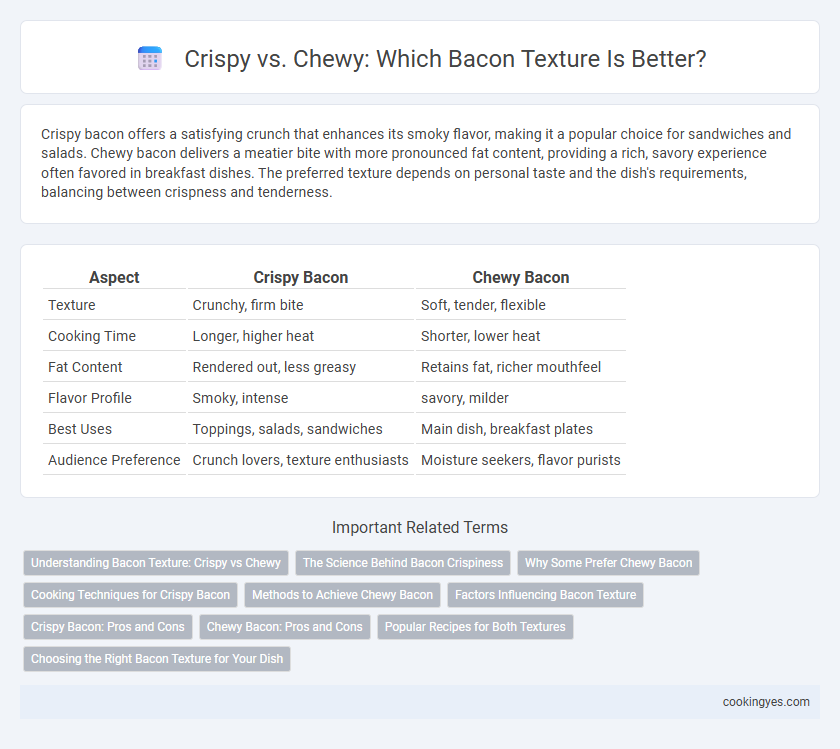Crispy bacon offers a satisfying crunch that enhances its smoky flavor, making it a popular choice for sandwiches and salads. Chewy bacon delivers a meatier bite with more pronounced fat content, providing a rich, savory experience often favored in breakfast dishes. The preferred texture depends on personal taste and the dish's requirements, balancing between crispness and tenderness.
Table of Comparison
| Aspect | Crispy Bacon | Chewy Bacon |
|---|---|---|
| Texture | Crunchy, firm bite | Soft, tender, flexible |
| Cooking Time | Longer, higher heat | Shorter, lower heat |
| Fat Content | Rendered out, less greasy | Retains fat, richer mouthfeel |
| Flavor Profile | Smoky, intense | savory, milder |
| Best Uses | Toppings, salads, sandwiches | Main dish, breakfast plates |
| Audience Preference | Crunch lovers, texture enthusiasts | Moisture seekers, flavor purists |
Understanding Bacon Texture: Crispy vs Chewy
Bacon texture varies primarily between crispy and chewy, determined by cooking time and fat content. Crispy bacon results from rendering most of the fat, creating a brittle, crunchy bite, while chewy bacon retains more fat, offering a tender, flexible texture. Understanding these differences helps optimize cooking techniques to achieve the preferred bacon texture for varied culinary uses.
The Science Behind Bacon Crispiness
Bacon crispiness results from the Maillard reaction and fat rendering during cooking, which create a crunchy texture by breaking down proteins and sugars at high temperatures. The balance between heat and cooking time determines whether bacon becomes crispy or chewy, as longer cooking melts more fat and removes moisture for crispiness, while shorter cooking retains moisture, producing a chewier bite. The thickness of the bacon slice and its fat content also influence texture, with thicker cuts and higher fat yielding a chewier experience.
Why Some Prefer Chewy Bacon
Chewy bacon offers a rich, tender bite that preserves more fat, providing a savory and moist texture favored by those who enjoy a balanced flavor profile. The slower cooking process that produces chewy bacon helps retain juiciness and a natural pork taste, making it ideal for dishes where bacon needs to blend harmoniously. Fans of chewy bacon appreciate its ability to complement softer foods without overpowering, delivering a satisfying mouthfeel distinct from the crunch of crispy bacon.
Cooking Techniques for Crispy Bacon
Cooking techniques for crispy bacon involve rendering fat slowly over medium-low heat to achieve even cooking without burning. Using a baking method on a wire rack in the oven allows excess grease to drip away, promoting a crisp texture. Pressing bacon with a spatula while frying can enhance contact with the pan for faster crisping and consistent crunch.
Methods to Achieve Chewy Bacon
To achieve chewy bacon, bake it at a lower temperature, around 325degF (163degC), allowing the fat to render slowly and the meat to retain moisture. Pan-frying over medium heat and flipping frequently helps prevent crispiness while maintaining tenderness. Another method is to partially cook bacon and finish it off at a lower temperature, preserving a chewy texture without becoming overly crisp.
Factors Influencing Bacon Texture
Bacon texture, whether crispy or chewy, is influenced primarily by cooking time, temperature, and cut thickness. Thinner slices cooked at higher temperatures for shorter durations tend to become crispier, while thicker cuts or lower heat with extended cooking retain chewiness. Fat content and curing methods also play crucial roles in determining the final texture by impacting moisture retention and rendering speed.
Crispy Bacon: Pros and Cons
Crispy bacon offers a satisfying crunch that enhances the overall eating experience and pairs well with sandwiches, salads, and breakfast dishes. Its lower fat content due to more rendered grease makes it a preferred option for those seeking a less greasy bite, but this can also result in a drier texture that some may find less flavorful. However, overcooking crispy bacon can lead to bitterness and a burnt aftertaste, making precise cooking crucial for optimal taste and texture.
Chewy Bacon: Pros and Cons
Chewy bacon offers a tender, flavorful bite that retains more fat, enhancing its rich taste and juiciness. This texture pairs well with sandwiches and salads where a balance of crispness and moisture is desired. However, chewy bacon may be less appealing to those who prefer a crunchy snack or need bacon that provides a crisp texture for garnishing.
Popular Recipes for Both Textures
Crispy bacon often stars in classic dishes like BLT sandwiches and bacon-wrapped appetizers, where its crunch complements fresh or tender ingredients. Chewy bacon is favored in hearty breakfasts, such as scrambled eggs or breakfast burritos, providing a rich, meaty texture that holds up in stews or salads. Both textures shine in popular recipes: crispy bacon adds a satisfying snap to salads and burgers, while chewy bacon enhances the savory depth in pasta carbonara and savory quiches.
Choosing the Right Bacon Texture for Your Dish
Crispy bacon offers a crunchy texture that complements salads, sandwiches, and burgers by adding a satisfying contrast to softer ingredients. Chewy bacon provides a tender, smoky bite ideal for breakfast dishes like scrambled eggs or casseroles where a richer, meaty presence enhances the overall flavor. Selecting the right bacon texture depends on balancing the dish's texture profile and the desired eating experience.
Crispy vs Chewy for Bacon Texture Infographic

 cookingyes.com
cookingyes.com